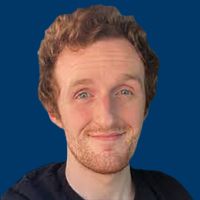Wealth of Newer Treatment Options Span the Scope of Multiple Myeloma and Amyloidosis
Tomer Mark, MD, discusses the emerging role of minimal residual disease as a surrogate end point in multiple myeloma, treatment selection for patients with newly diagnosed, early relapsed, and late relapsed disease, and the importance of daratumumab being introduced to the treatment paradigm of amyloidosis.
Tomer Mark, MD

Treatment selection for patients with newly diagnosed, early relapsed, and late relapsed multiple myeloma requires consideration of patient-, disease-, and treatment-related factors, said Tomer Mark, MD. He added that the need for minimal residual disease (MRD) as a surrogate end point for survival is stronger now, with optimal sequencing strategies remaining uncertain.
“Multiple myeloma [treatment] is moving very fast right now. A lot of new agents … are exciting, including oral options. There is an embarrassment of riches in terms of treatment, so we have to sift through this treasure to find the best treatment for the right patient at the right time,” said Mark in an interview with OncLive® during an Institutional Perspectives in Cancer (IPC) webinar on multiple myeloma.
Mark discussed the emerging role of MRD as a surrogate end point in multiple myeloma; treatment selection for patients with newly diagnosed, early relapsed, and late relapsed disease; and the importance of daratumumab (Darzalex) being introduced to the treatment paradigm of amyloid light-chain (AL) amyloidosis. He is an associate professor of medicine, clinical director of the Plasma Cell Disorders Program, and clinical director of the Autologous Stem Cell Transplant Program, in the Department of Medicine – Hematology at the University of Colorado (UC) School of Medicine, of UCHealth.
OncLive®: What data stood out to you from the 2021 ASH Annual Meeting and Exposition regarding MRD as a surrogate end point for survival in multiple myeloma?
Mark: We are seeing the continued theme of MRD and how important it is as an end point. Although not quite universally accepted as a surrogate marker for survival, it certainly is much closer than what we had before with the IMWG [International Myeloma Working Group] criteria. It is good to see that more studies are using MRD as an end point. Also, it’s good that more patients are reaching that end point, even in the relapsed/refractory setting. We are seeing that in the CAR T-cell therapy studies with idecabtagene vicleucel [ide-cel; Abecma] and ciltacabtagene autoleucel [cilta-cel] that close to 50% of patients are reaching MRD negativity. Extended results with the use of monoclonal antibodies in the up-front setting, like the GRIFFIN study [NCT02874742], also show continued MRD negativity with continued treatment. Getting these very deep responses is the theme now, which is refreshing. Now our problem returns full circle to sequencing, which used to be a big issue a few years ago.
What was the main message from the presentation given by Peter Forsberg, MD, of the University of Colorado Cancer Center, at the IPC meeting on frontline therapy?
The message is that incorporation of a monoclonal antibody as part of induction therapy provides a great benefit that is durable to patients. Incorporating the monoclonal antibodies [into frontline treatment] is going to become the standard of care. The data we saw at [the 2021 ASH Annual Meeting and Exposition] simply reinforced those results.
One of the presentations you gave during the IPC event focused on early relapsed multiple myeloma. How are you currently approaching treatment selection with CD20-directed monoclonal antibodies in this setting?
The ICARIA-MM [NCT02990338] and IKEMA [NCT03275285] studies looking at isatuximab-irfc [Sarclisa] in combination with either carfilzomib [Kyprolis] or pomalidomide [Pomalyst] showed outstanding results in terms of nearly a halving of the risk of progression at any point in time. The hazard ratio was between 0.5 and 0.6 in both studies.
Subgroup analyses were refreshing in that age and cytogenetics didn’t seem to have much of an effect [on survival] or at least not as much of an effect as they used to with older agents. The theme continues of using monoclonal antibodies early on in therapy. One point to make about that is that sequential CD38-directed antibodies, no matter the order of daratumumab or isatuximab first followed by the other, does not seem to be an effective strategy. There needs to be a period between those sorts of therapies.
Daniel Sherbenou, MD, PhD, of the University of Colorado Cancer Center, spoke about late relapsed multiple myeloma, specifically calling out several therapies approved for use in this patient population. How are you sequencing agents like selinexor (Xpovio), belantamab mafodotin-blmf (Blenrep), and CAR T-cell therapy?
That is the major question [in this setting]. There are clinical trials looking at moving CAR T-cell therapy, as well as bispecific antibodies, closer to the frontline [setting]. We are still learning how to manage toxicities from these therapies, like cytokine release syndrome and immune effector cell–associated neurotoxicity syndrome. As we gather more data, these things are getting more predictable and we are managing them better; however, we are keeping patients in the hospital for 2 weeks to get their CAR T cells because we just don’t know what will happen. With bispecific antibodies, we have step-up dosing because we just don’t know what will happen. We need more experience with these agents.
That said, eventually, CAR T-cell therapy will become part of the standard of care at some point. Just like autologous stem cell transplant, [CAR T-cell therapy] requires some planning, so CAR T-cell therapy may be used in a more elective situation, not as a rescue therapy for patients. Perhaps, the decision will be made based on MRD status after induction. That has yet to be determined.
In emergent situations, we can use bispecific antibodies, which are the off-the-shelf T-cell harnessing therapies. There are practical reasons for using [bispecific antibodies] vs [CAR T-cell therapy].
One nice thing we saw is that we can give sequential anti–BCMA-directed therapy, which is the opposite of what we know about [sequential] monoclonal antibodies. That means that we don’t have to be as careful in terms of planning whether we are going to give belantamab mafodotin followed by anti–BCMA-directed CAR T-cell therapy vs the other way around. Of course, there are some issues with belantamab mafodotin, such as corneal toxicities. The results of belantamab mafodotin in combination with dexamethasone were disappointing, although the later DREAMM trials [evaluating belantamab mafodotin] in combination with bortezomib [Velcade] showed much better results.
It seems that belantamab mafodotin is not destined to be a single-agent therapy and it will be used in combination. It is off-the-shelf, so that is a plus given that we need an ophthalmologic exam before each dose, which is a big minus. In an academic or large hospital where the ophthalmologist is down the hall, that isn’t a problem, but in the community clinics where the ophthalmologist is across town, that isn’t as practical. These things get baked into the equation.
Your second presentation centered on the evolving role of CAR T-cell therapy in relapsed/refractory multiple myeloma. Recognizing the flaws of cross-trial comparisons, how do the data with ide-cel compare with those of cilta-cel?
When we look at comparisons over time, it seems that cilta-cel is a bit more effective than ide-cel. I’d like to exercise caution [comparing] apples and oranges. The ide-cel population [comprised] sicker patients in general with higher-risk cytogenetics and higher-risk multiple myeloma. I imagine that if ide-cel were used in a very similar patient population to [the one in which] cilta-cel [was evaluated] this difference might not be so great. We are comparing 2 amazing therapies. For ide-cel, we have seen response rates around 80% with durations of response [DOR] lasting close to 1 year. With cilta-cel, we are looking at 90% to 100% response rates in some studies and a DOR not yet reached.
I get asked this question all the time: Which therapy should I give to give to my patients? The answer is whichever is available. There are manufacturing and supplier problems, as well as slot allocation problems for apheresis and lymphocyte collection. We are grabbing whatever opportunity we get.
Dr Forsberg also discussed amyloid light-chain (AL) amyloidosis, calling out the FDA accelerated approval of frontline daratumumab plus hyaluronidase-fihj (Darzalex Faspro) in combination with bortezomib, cyclophosphamide, and dexamethasone. What significance does this approval have for this patient population?
It was amazing to perform such a large, randomized trial in AL amyloidosis. I am proud to have participated in this study. It has probably set the world record for the fastest accrual to an amyloidosis trial. That shows the faith that we have in daratumumab working.
The addition of daratumumab to [AL amyloidosis] treatment is probably as significant as the first use of proteasome inhibitors in amyloid treatment. It really is a sea change, and the difference in terms of progression-free survival and organ recovery is so profound that there is no question that daratumumab should be part of frontline care for AL amyloidosis. This is especially [true] for patients who are not transplant eligible.
In transplant-eligible patients, it is more of a question of whether we should transplant patients more up front and then [continue] later with antibody therapy. That is going to be a practical matter in terms of [evaluating] plasma-cell burden, how sick are they, and how many organs are affected. Overall, outcomes for [patients with] amyloidosis are much better now that we have this treatment.
Would you like to highlight research that you are taking part in that has the potential to further inform treatment selection in multiple myeloma?
We are working on developing an ex-vivo drug testing platform for patients with multiple myeloma. It is well known that myeloma is not one disease, it is many diseases, which accounts for the variety of outcomes we can see with therapy. This is an effort to tailor the therapy to that patient’s particular myeloma phenotype, meaning how it behaves in real life. This is opposed to risk-adapted therapy where we make guesses based on high-risk cytogenetics or mutations.
Of course, this only accounts for one aspect of a disease in which there are multiple mutations and clones going on at the same time. Our institution is focused on getting primary patient myeloma samples, real myeloma cells as opposed to cell lines, putting them in cultures with various drugs being tested, and making a prescription for the patient based on this. This is all experimental and more work needs to be done. We are just now doing our translational studies where we are testing this principle out in a clinical trial setting.



